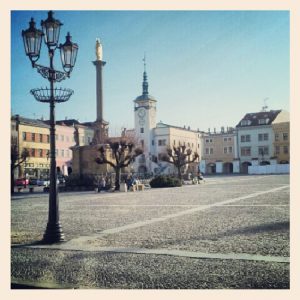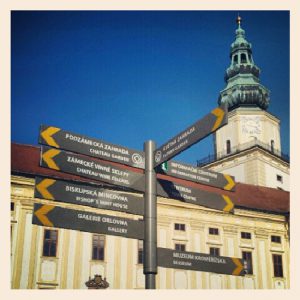Kromeriz Chateau and gardens
By Tracy A. Burns
 The northern Moravian town of Kromeriz features not only the Baroque Archbishop’s Palace but also three extensive gardens: the castle’s Baroque Pleasure Garden and 19th-century English garden as well as The Flower Garden which is located about a 10-minute walk away. The palace, also sometimes referred to as a chateau, and gardens have been recognized as a National Cultural Monument of the Czech Republic since 1995 and also has appeared on UNESCO’s World Natural and Cultural Inheritance List in 1998. The interiors of the palace were used in Milos Forman’s film, Amadeus, representing Vienna’s Hofburg Imperial Palace.
The northern Moravian town of Kromeriz features not only the Baroque Archbishop’s Palace but also three extensive gardens: the castle’s Baroque Pleasure Garden and 19th-century English garden as well as The Flower Garden which is located about a 10-minute walk away. The palace, also sometimes referred to as a chateau, and gardens have been recognized as a National Cultural Monument of the Czech Republic since 1995 and also has appeared on UNESCO’s World Natural and Cultural Inheritance List in 1998. The interiors of the palace were used in Milos Forman’s film, Amadeus, representing Vienna’s Hofburg Imperial Palace.
The rooms in the palace
 The palace offers tours of its historical rooms, picture gallery, sala terrena with exquisite stucco decoration, and tower. It also contains a musical archive. The Archbishop’s wine cellars and a mint are other areas to explore on the grounds. The former main residence of bishops is owned by the National Monument Institution in Brno.
The palace offers tours of its historical rooms, picture gallery, sala terrena with exquisite stucco decoration, and tower. It also contains a musical archive. The Archbishop’s wine cellars and a mint are other areas to explore on the grounds. The former main residence of bishops is owned by the National Monument Institution in Brno.
The history of the chateau
Originally built as a Gothic castle in the 13th century, the building was changed into a chateau at the beginning of the 16th century. One of the oldest noble dynasties after whom a country is named, the Liechtensteins had the palace transformed into Baroque style in 1664. Destroyed by a fire in 1752, the current chateau is about 300 years old. The tower was damaged by a grenade hurled by the Germans in the last days of World War II. The residence of the archbishops of Olomouc since 1777 is set on the edge of the town’s picturesque main square.
The Hunting Hall
Furnished for a meeting between Russian Czar Alexander III and Austro-Hungarian Emperor Franz Joseph I in August of 1885, the Hunting Hall is the first room on the tour and also one of the most lavish. Along with 41 hunting trophies, spears, knights’ suits of armor and a copy of a Peter Paul Rubens’ painting make up the walls’ décor. The two dignitaries held their meeting in the Czar’s Room, which includes a portrait of the young future emperor Franz Joseph I without his characteristic mustache and beard, an exquisite large green vase from Czar Alexander III, and two 17th-century jewelry boxes. A unique white sculpture titled “A Mother’s Love” also stands in the room.
The Pink Salon and other spaces
The Pink Salon is charming with its Venetian mirror, 16th-century paintings by Jacobo Bassano, a 200-year-old chandelier made of Czech glass, and Rococo tiled stove decorated in white and gold. The Advisory Hall serves as a portrait gallery of Olomouc’s former bishops and archbishops while the Throne Hall exhibits much more than just a throne: Exactly 99 paintings cover the walls, some of which focus on biblical themes while others feature animal motifs. Be sure to glance upwards at the stucco ceiling with gold decoration and to glance down at the parquets on the floor; they are original and handmade, between 100 and 150 years old.
The dining room
The Big Dining Room is the biggest and most enchanting room in the chateau. White with golden stucco decoration, the 30-meter long and 16-meter high hall contains ceiling frescoes, 14 chandeliers from Venetian glass, 440 candles plus a few stunning paintings on the walls. In 1848 the space took on a political dimension as it was the meeting place of the Kromeriz Congress of Austrian nations, which tried unsuccessfully to solve the nationalistic problems plaguing the monarchy. That year many Czech historical figures, including famous Czech historian Frantisek Palacky, set foot in this room.
The second floor
The second floor is punctuated by the striking Feudal Hall with a historical mural on the ceiling that incorporates symbols denoting the power and strength of the Olomouc Church. The author of the ceiling painting is Viennese artist Franz Anton Maulbertsch. Another gem of the second floor is the multi-room library, which contains 33,641 leather-bound books, written in German, Czech, and Latin. It also features 304 manuscripts, 180 first editions, 1,178 volumes from the 16th century, and about 20,000 prints from the 18th century or earlier. The interior was designed at the end of the 18th century, and the four big globes in the last room of the library go back to the 17th century. Don’t forget to look up at the exquisite ceiling paintings. They were created by Moravian painter Josef Stern between 1759 and 1760. The smaller library room also contains a numismatic collection of coins and medals, including ducats made in the 16th century.
The picture gallery
The chateau’s picture gallery is the second most well-reputed art collection in the Czech lands. It boasts 85 originals from the 15th to the 18th century, including works by Titian, Paolo Veronese, Jacobo Bassano, Jan I. Brueghel, Sir Anthony van Dyck and Lucas Cranach the Elder. The gallery includes 16th-century paintings from the Netherlands and Germany, Dutch and Flemish portraits and landscapes from the 17th century-plus Italian paintings from the 15th, 16th, and 17th centuries. Perhaps its most renowned piece is Titian’s The Flaying of Marsyas from circa 1571.
The gardens
The romantic chateau gardens are as impressive as the interior. Dating from Baroque times, the 64 hectares of gardens feature a colonnade, an Italian terrace, stone obelisks, statues, fountains, a pond, a silver bridge, a Chinese pavilion, a portico, three sala terrena, and two grottoes with early Baroque stucco decoration. A 19th-century English garden, damaged by the floods of 1997, is also on the premises.
The Flower Garden
Yet the chateau gardens are by no means the only gardens in town. The Flower Garden is shaped as an elongated rectangle and modeled in Spanish, French, and Italian styles. Hailing from the late Renaissance, it was founded during the period of 1665-1675 when the town was being rebuilt after having been destroyed in the Thirty Years’ War. The garden’s 244-meter colonnade is decorated with 44 sculptures of ancient figures and an arcade with 46 busts. The floral decoration in front of the colonnade is practically bursting with rich, bright colors. The two fountains, the Lion Fountain and the Triton Fountain, also boast sculptural decoration. The eight-sided rotunda is designed with ornate stucco decoration and features grottos as well as a copula and lantern. There are also ponds, a glasshouse, a hothouse, and an aviary.
Enchanting Kromeriz
 Kromeriz is one of the most beautiful towns in the country with its gardens and palace. The streets are also picturesque, adding to the romantic atmosphere. One of the highlights of the Czech Republic, Kromeriz is not to be missed when traveling through Moravia.
Kromeriz is one of the most beautiful towns in the country with its gardens and palace. The streets are also picturesque, adding to the romantic atmosphere. One of the highlights of the Czech Republic, Kromeriz is not to be missed when traveling through Moravia.




